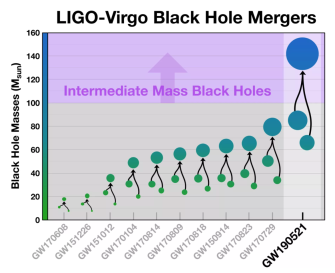Key Takeaways:
- First-ever detection of an intermediate-mass black hole formed by the merger of two mid-sized black holes, weighing 66 and 85 times the mass of the Sun, creating a new black hole of approximately 142 solar masses.
- This discovery offers a significant insight into the existence of intermediate-mass black holes, a category largely unexplored until now, bridging the gap between stellar-mass and supermassive black holes.
- The formation of these intermediate-mass black holes remains a mystery, as they are thought to exist outside the conventional understanding of black hole formation, challenging current astrophysical models.
- The possibility that intermediate black holes could evolve into supermassive ones through a process of repeated mergers raises intriguing questions about the hierarchical nature of black hole formation.
- Ongoing research by the LIGO-Virgo collaboration aims to further study this newfound intermediate black hole, named GW190521, leveraging improved instruments to deepen our understanding of these cosmic phenomena.
In a groundbreaking astronomical revelation, the scientific community has witnessed the cosmic spectacle of the first-ever detection of an intermediate-mass black hole resulting from the cosmic union of two mid-sized black holes. The reverberations of this colossal event, which occurred approximately 7 billion years ago, finally reached Earth in May 2019 in the form of four fleeting gravitational waves.
The merging of two black holes, weighing 66 and 85 times the mass of our Sun, into a solitary black hole approximately 142 times the mass of the Sun, marked an unprecedented observation in the annals of astrophysics. Alan Weinstein, a physicist from Caltech involved in this epochal discovery, likened this cataclysmic occurrence to “the biggest bang since the Big Bang” observed by humankind.
This extraordinary revelation, however, revealed a celestial paradox. While this cosmic collision delivered an immensely powerful event, the resulting black hole belonged to a unique category known as “intermediate-mass.” This class, spanning sizes ranging from about 50 to 1,000 times the mass of our Sun, represents a domain that scientists have explored sparingly until now.
The existence of these mid-sized black holes has long eluded scientific scrutiny. While smaller black holes, a few times more massive than the Sun, and supermassive black holes, exceeding six billion solar masses, have been documented, the tangible evidence of intermediate-mass black holes remained an enigmatic quest.
Christopher Berry, a professor at Northwestern University, expressed the significance of this breakthrough in acknowledging the existence of intermediate-mass black holes. He articulated that this milestone event provided conclusive proof of a celestial entity that had long evaded direct detection.
However, the formation mechanism behind these intermediate-mass black holes poses a profound conundrum. Existing astrophysical theories suggest that smaller black holes form from the explosive demise of stars, known as supernovas. Yet, the current understanding negates the plausibility of mid-sized black holes originating from this process due to a stellar mass range that leads to a stellar explosion without leaving behind a black hole.

Contrary to these theories, the growth of supermassive black holes, situated at the core of galaxies, is believed to stem from the accumulation of cosmic matter, including smaller black holes. It is hypothesized that intermediate black holes might evolve through a series of mergers involving smaller black holes.
This revelation sparks intriguing speculations about the potential evolution of an intermediate black hole towards the colossal status of a supermassive black hole. Martin Hendry, a professor at Glasgow University, highlighted the possibility of a hierarchical progression where the 142-solar-mass black hole might have merged with other massive counterparts, mirroring a process leading to the formation of supermassive black holes at the heart of galaxies.
Despite shedding illuminating insights into the formation of black holes, this discovery leaves many fundamental questions unanswered. Researchers collaborating within the LIGO-Virgo initiative aspire to delve deeper into the study of this newfound intermediate black hole, named GW190521. They anticipate harnessing enhanced instruments, set to be operational in 2021, to unravel more mysteries surrounding these cosmic marvels.
The groundbreaking revelation, chronicled in two published papers within the Physical Review Letters and The Astrophysical Journal Letters, signifies a crucial milestone in our understanding of celestial phenomena. The ability to detect a black hole spanning a few hundred kilometers from halfway across the Universe stands as a testament to the profound advancements in astronomical observation and detection capabilities.
This unprecedented detection marks a pivotal moment in astronomical history, sparking renewed fervor and dedication among researchers to decode the enigmatic nature of black holes and unravel the mysteries of the cosmic realm.


